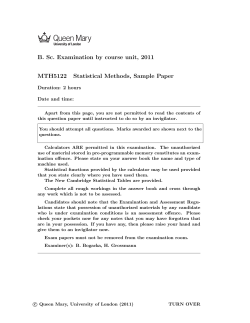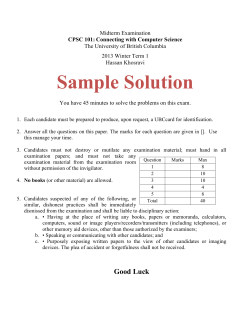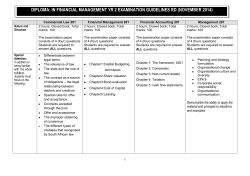
Elementary Computer Application (Compulsory Paper) Syllabus and Course Scheme
Syllabus and Course Scheme Academic year 2014-15 Elementary Computer Application (Compulsory Paper) UNIVERSITY OF KOTA MBS Marg, Swami Vivekanand Nagar, Kota - 324 005, Rajasthan, India Website: uok.ac.in UNIVERSITY OF KOTA, KOTA ELEMENTARY COMPUTER APPLICATION (Compulsory Paper) (B.A./B.Sc./B.Com.) Pt.I Exam-2015 Scheme: Duration : 3 Hrs. M.M.Pass Marks:22 Theory :60 Duration : 2 Hrs. M.M.Pass Marks:14 Practical:40 Multiple Questions-120 and O.P.of four series for theory. Each question shall carry 1/2 mark, with no negative marking. As such, 1/2 mark shall be awarded for the correct answer in each question. Note: 1. The marks secured in this paper shall not be counted in awarding the division to a candidate. 2. The candidate has to clear compulsory paper in three chances. 3. Non appearing or absent in the examination of compulsory paper will be counted a chance. Syllabus for compulsory paper of “Elementary Computer Applications” in the first year of B.A./B.Sc./B.Com. Courses: 1. Introduction to Information Technology: evolution and generation of computers, types of computers, micro, mini, mainframe and super computer, Architecture of a computer system: CPU, ALU, Memory (RAM, ROM fmilies), cache memory, input/output devices, pointing devices. 2. Number system: Binary, octal, decimal and hexadecimal) and their interconversions, character codes (ASCII, EBCDIC and Unicode). Logic gates. Boolean Algebra, machine, assembly and high level language including 3 GL and 4 GL. 3. Concept of Operating system: types of operating systems, need of OS, batch processing, multi-processing, Single user & Multi user OS, distributed and time sharing operating systems, Process and memory management concept, Introduction to Unix, Linux, Windows, Windows NT systems and their simple commands. 4. Internet: Concepts, email services, world wide web, web browsers, search engines, simple programs in HTML, Types of HTML documents, Document structure element, Type and character formation, Tables, Frames and forms. 5. Word processing packages: standard features like tool bar, word wrap, text formatting, paragraph formatting. Effect to text. Mail-merge. 6. Presentation packages: Slide creation, slide shows, adding graphics, formatting, customizing and printing, custom and animation. 7. Computer networking: Type of networks, LAN, MAN and WAN, concept of bridges and routers, gateways and modems. ISDN and leased lines, Teleconferencing and videoconferencing. 8. Multimedia Technology: Introduction, framework for multimedia devices, image compression standards, JPEG, MPEG and MIDI formats. 9. Database Management Systems: Data, field and records, information database, creation of a database file, insertion, deletion and updating of records, modifying structure, editing and browsing of records, searching, sorting and indexing of records, retrieving of records and report generation. Data processing in government organizations. 10. E-commerce: Concept of e-commerce, benefits and growth of ecommerce, security considerations and hazards of virus and other security risks, anti-virus software, electronic payment system. LAB : Internal and External MS-DOS commands, Window-98. MS-Office Packages (MS-Word & MS-Excel). Note: 1. Passing in Theory and Practical examinations separately shall be necessary by securing at least 36% marks. Maximum marks for theory will be 60 and maximum marks for practical paper will be 40. Minimum passing marks for theory and practical shall be 22 and 14 respectively. 2. The theory Q. P. will carry 120 multiple choice questions of 1/2 marks each. Question paper of four series shall be printed. 3. The practical examination scheme should be as follows:a. Record/sessionals 6 marks b. Viva-voce 6 marks c. practical Exercise (DOS) 7 marks d. practical Exercise (Window 98) 7 marks e. practical Exercise (MS-Word) 7 marks f. practical Exercise (MS-Excel) 7 marks 4. Duration for practical examination shall be of 2 hours and not more than 2 batches of 20 students, each should be examined in a day by Single examiner.
© Copyright 2025





















